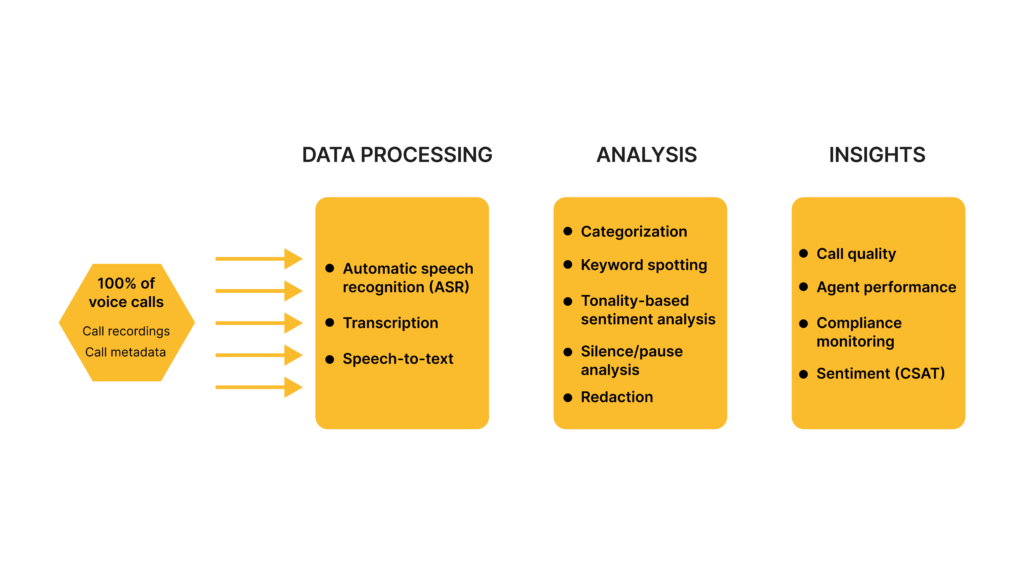Extracting Insights from Customer Interactions

Call centers play a vital role in business success by addressing customer inquiries and issues swiftly and empathetically, fostering customer loyalty. Speech analytics tools empower contact center agents by providing deep insights into customer thoughts, emotions, and behaviors, enhancing their performance. These tools add a scientific dimension to human interactions, enabling real-time analysis of vast datasets. This not only aids agents during calls but also helps identify broader trends, like recurring product issues causing customer frustration. Speech analytics, involving call transcription and analysis, is increasingly adopted across industries, positively impacting key metrics such as average handle time, first call resolution, and customer satisfaction.
Speech analytics workflow
Speech analytics software functions by gathering and assessing data from customer conversations, and presenting this information through dashboards, reports, and call transcripts. Dashboards offer real-time insights for contact center agents and managers, covering call volume, agent effectiveness, customer sentiment, and other relevant metrics. Call transcripts serve as precise, searchable records of customer interactions, valuable for training and quality assurance.
The process involves three phases, collectively working to extract profound insights, trends, and metrics from every call for strategic decision-making and contact center enhancements. It commences with injecting 100% of voice calls and metadata into the speech analytics software, initiating the following steps:
- Data Processing: The technology employs various artificial intelligence services, including automatic speech recognition, transcription, and sentiment analysis based on tonality, to examine both audio recordings and call metadata.
- Analysis: After evaluating the call recordings, speech analytics categorizes them, identifies keywords, redacts sensitive information for compliance, and generates analysis reports.
- Insights: The speech analytics platform then presents comprehensive reports on the analysis, covering aspects such as call quality, sentiment, agent performance, and compliance.
Benefits of speech analytics
Speech analytics offers a multitude of benefits, although the specific advantages can vary based on factors such as an organization’s size, industry, and agent volume. However, some of the most prevalent and enduring benefits include:
- Enhanced Call Coverage: Traditionally, QA teams in call centers would quality-check only 2 to 4 voice calls per agent each month. With speech analytics, organizations can scrutinize as much as 100% of voice calls, significantly increasing coverage.
- Key KPI Monitoring and Quality Assurance Boost: Speech analytics empowers customer service and support teams to analyze various aspects of customer interactions, including supervisor escalations, compliance adherence, customer satisfaction, and average handle time (AHT). It identifies areas where agents may fall short of quality benchmarks, offering actionable insights for improvements and enhancing quality assurance, a critical component of contact center operations.
- Near-Real-Time Feedback: Speedy analysis and comprehensive call coverage enable supervisors to provide tailored feedback to agents almost instantly. The adoption of Real-Time AI in many contact centers further enhances in-the-moment agent guidance and feedback. Additionally, speech analytics uncovers valuable business intelligence, providing customer insights on needs and trends to inform strategic initiatives.
- Improved Operational Efficiency: Speech analytics reduces the need for time-consuming review processes, enabling contact centers to optimize operational efficiency and manage larger call volumes. Speech-to-text functionality equips agents to enhance their self-service capabilities, freeing up contact center resources to handle more complex issues that require live agent assistance.
- Identification of Hidden Inefficiencies: By monitoring various contact center KPIs, leadership gains a deeper understanding of factors affecting these indicators and can pinpoint hidden inefficiencies that impact performance.
- Personalized Training: Insights derived from analyzing 100% of customer calls per agent empower supervisors and Learning & Development teams to design custom coaching sessions tailored to individual agents.
- Improved Customer Experiences: Speech analytics provides detailed insights into customer needs and preferences. Through sentiment analysis, teams can identify elements contributing to positive customer experiences, such as empathy statements, as well as indicators of negative experiences, such as supervisor escalations. This data-driven approach helps reduce customer churn.
- Accurate QA Process Automation: Effective speech analytics enables precise call ingestion and more efficient automation of the QA process, expanding and deepening insights gained from customer interactions.

